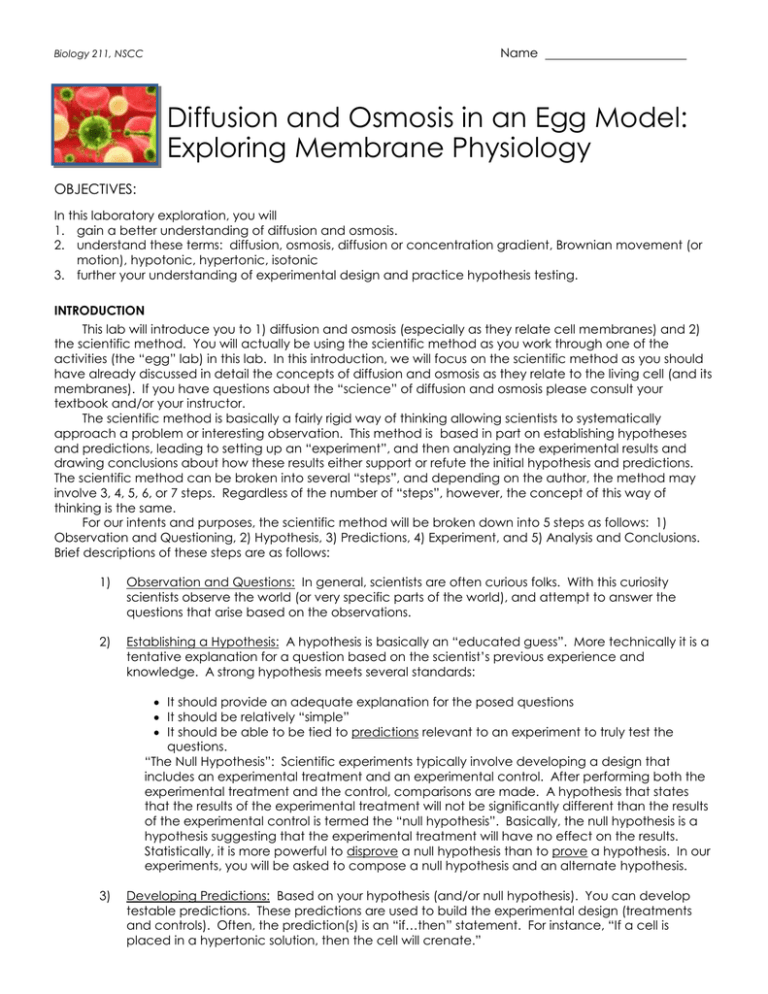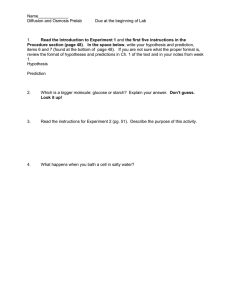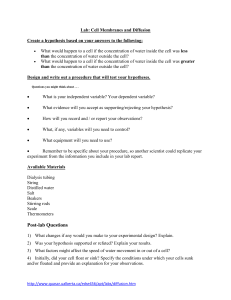Diffusion and Osmosis in an Egg Model: Exploring Membrane Physiology OBJECTIVES:
advertisement

Biology 211, NSCC Name Diffusion and Osmosis in an Egg Model: Exploring Membrane Physiology OBJECTIVES: In this laboratory exploration, you will 1. gain a better understanding of diffusion and osmosis. 2. understand these terms: diffusion, osmosis, diffusion or concentration gradient, Brownian movement (or motion), hypotonic, hypertonic, isotonic 3. further your understanding of experimental design and practice hypothesis testing. INTRODUCTION This lab will introduce you to 1) diffusion and osmosis (especially as they relate cell membranes) and 2) the scientific method. You will actually be using the scientific method as you work through one of the activities (the “egg” lab) in this lab. In this introduction, we will focus on the scientific method as you should have already discussed in detail the concepts of diffusion and osmosis as they relate to the living cell (and its membranes). If you have questions about the “science” of diffusion and osmosis please consult your textbook and/or your instructor. The scientific method is basically a fairly rigid way of thinking allowing scientists to systematically approach a problem or interesting observation. This method is based in part on establishing hypotheses and predictions, leading to setting up an “experiment”, and then analyzing the experimental results and drawing conclusions about how these results either support or refute the initial hypothesis and predictions. The scientific method can be broken into several “steps”, and depending on the author, the method may involve 3, 4, 5, 6, or 7 steps. Regardless of the number of “steps”, however, the concept of this way of thinking is the same. For our intents and purposes, the scientific method will be broken down into 5 steps as follows: 1) Observation and Questioning, 2) Hypothesis, 3) Predictions, 4) Experiment, and 5) Analysis and Conclusions. Brief descriptions of these steps are as follows: 1) Observation and Questions: In general, scientists are often curious folks. With this curiosity scientists observe the world (or very specific parts of the world), and attempt to answer the questions that arise based on the observations. 2) Establishing a Hypothesis: A hypothesis is basically an “educated guess”. More technically it is a tentative explanation for a question based on the scientist’s previous experience and knowledge. A strong hypothesis meets several standards: It should provide an adequate explanation for the posed questions It should be relatively “simple” It should be able to be tied to predictions relevant to an experiment to truly test the questions. “The Null Hypothesis”: Scientific experiments typically involve developing a design that includes an experimental treatment and an experimental control. After performing both the experimental treatment and the control, comparisons are made. A hypothesis that states that the results of the experimental treatment will not be significantly different than the results of the experimental control is termed the “null hypothesis”. Basically, the null hypothesis is a hypothesis suggesting that the experimental treatment will have no effect on the results. Statistically, it is more powerful to disprove a null hypothesis than to prove a hypothesis. In our experiments, you will be asked to compose a null hypothesis and an alternate hypothesis. 3) Developing Predictions: Based on your hypothesis (and/or null hypothesis). You can develop testable predictions. These predictions are used to build the experimental design (treatments and controls). Often, the prediction(s) is an “if…then” statement. For instance, “If a cell is placed in a hypertonic solution, then the cell will crenate.” Biology 211: Diffusion and Osmosis in an Egg Model 2 4) Constructing Experiments: Using your hypothesis and prediction(s), you will set-up an experiment. A good experiment should be as simple as possible (while still addressing the problems), and reproducible (by other scientists). The experimental design should be developed to test one variable and compare it to a control. The experimental variable to be tested is often varied in the experiment to test the effects of a range on the “subject”. 5) Analyzing Results and Drawing Conclusions: The results of the experiment(s) are analyzed in light of the hypothesis and predictions already established. First, the researcher must determine if the results between the experimental treatment and then control are statistically significant. Statistical tests are used to measure the “differences” between the two and if the differences are determined to be statistically significant, then the conclusion drawn is that the “null hypothesis is refuted (not supported)”. If this conclusion is drawn, the alternate hypothesis and predictions, consequently, are supported. For the egg lab, described below, you will set-up hypotheses (null and alternate) and predictions based on these hypotheses. Since this is our first time hypothesis testing, we have already set-up the experimental design and you will follow it as written below. After the experiment, you can analyze the results and draw conclusions about whether to support the null hypothesis or refute the null hypothesis (and therefore, support the alternate hypothesis). In addition to the egg lab, you will work on two other activities observe a demonstration illustrating other concepts studied in class. The procedures for these are all described below. MATERIALS (per group) FOR THE “EGG LAB” two prepared eggs two beakers tray for containing the eggs, etc. scale or balance 2 weigh boats paper towels PROCEDURES Part 1: Demonstration of Diffusion and Osmosis 1. A demonstration dialysis slide and a beaker of solution with the following contents will have been setup before class: Contents of Dialysis Slide Water Starch Contents of Beaker Water Iodine 2. Based on an understanding of the dialysis membrane, what are your hypotheses and predictions regarding the movement of water molecules and solute particles when the dialysis slide is placed into the beaker? (You’ll answer these questions in your pre-lab!) 3. Record the results of the demonstration experiment (and your observations!) and draw conclusions regarding your hypotheses and predictions in your lab notebook. Part 2: The “Egg Lab”: Determining the Relative Concentration of Two Solutions by Osmosis In this portion of the lab, you will be given two solutions. Your job is to determine which is the hypertonic solution. You will be able to do this by using "model cells". We will model cells by using eggs. “Eggs??!!” you exclaim. Yes, eggs! They have been specially prepared to make the egg shell soft by soaking them in vinegar. This makes them permeable to water. 1. Based on your understanding of the scientific method from the reading above and any further explanations, generate a hypothesis and prediction for your experiment. Your hypothesis should be a general statement about diffusion and/or osmosis; while, your prediction should be a specific statement about the expected outcome of the experiment. Often predictions are framed as “If…then…” statements. 2. To begin the experiment (after your hypothesis and predictions have been written) carefully weigh each egg (gently drying it off beforehand). Use the weighing dish to prevent the egg from rolling off the balance. Record the data in an appropriate table in your lab notebook. Biology 211: Diffusion and Osmosis in an Egg Model 3 3. Place each egg into a beaker with solution for 40 minutes, keeping track of which egg went in which beaker! 4. Every 10 minutes, remove each egg, dry it off, and weigh it again as in #2. Record the data and return the egg to the correct solution promptly. 5. Analyze your data and draw conclusions about your hypotheses and predictions based on this analysis. Part 3: Plasmolysis -- Observing Osmosis in a Living System If a plant cell is immersed in a solution that has a higher solute concentration than that of the cell, water will leave/enter (circle one) the cell. The loss of water from the cell will cause the cell to lose the pressure exerted by the fluid in the plant cell’s vacuole, which is called turgor pressure. Macroscopically, you can see the effects of loss of turgor in wilted house plants or “limp” lettuce. Microscopically, increased loss of water and loss of turgor become visible as a withdrawal of the protoplast from the cell wall (plasmolysis) and as a decrease in the size of the vacuole (Figure 1). Figure 1. Plasmolysis in an epidermal cell of a leaf: (a) Under normal conditions, the plasma membrane is pressed against the cell walls. A large vacuole occupies the center of the cell, pushing the cytoplasm and nucleus to the periphery. (b) When the cell is placed in a solution with a higher concentration of solutes than that of the cell, water passes out of the cell, and the cell contents contract. (c) In an even more concentrated solution, the cell contents contract still further. 1. Obtain a leaf from an Elodea plant. Place it in a drop of water on a slide, cover it with a coverslip, and examine the material first at low power (100X) and then at high power (400X). 2. Locate a region of healthy cells and sketch a few adjacent cells in your lab notebook. Note especially the location of the chloroplasts. (Don’t forget to include total magnification and label structures in your sketch!) For the next step, do NOT move the slide. 3. While touching one corner of the coverslip with a piece of Kimwipe to draw off the water, add a drop of concentrated salt solution to the opposite corner of the coverslip. Be sure that the salt solution moves under the coverslip. Wait about 5 minutes, then examine as before. 4. Sketch the cells again in your lab notebook, again noting magnification and labeling any structures you can identify. Part 4: Diffusion in Agar Cells (the relationship between diffusion and cell size) In this portion of the lab, you will be given a block of agar that you will cut into 3 sizes. We will use these 3 size blocks to demonstrate the effect of size on diffusion. The agar has been made with phenolphthalein in it, which will act as a color indicator when it comes in contact with the base used in the experiment. 1. Each group will cut 3 agar cubes (a 3 cm cube, a 2 cm cube, and a 1 cm cube) from the block of agar available. Cut as accurately as possible. 2. Pour 200 ml of 0.1 M NaOH solution into the 400 ml beaker. Note the time and immerse the 3 blocks in the NaOH solution. Let the cubes soak for 10 minutes. 3. After the 10 minute soak, remove the agar cubes and blot them dry with a paper towel. 4. Promptly cut each cube in half and measure the depth to which the pink color has penetrated. In other words, measure from one edge how far to the center the pink color penetrated. 5. Record the results in your lab notebook. 6. Calculate the surface area to volume ratio, and then the diffusion rate for each of your cubes. You might choose to present this in your notebook in a table similar to the one below Biology 211: Diffusion and Osmosis in an Egg Model Cube Surface Area (cm2) Volume (cm3) 4 Surface Area to Volume Ratio Diffusion Depth (mm) Diffusion Rate (mm/min) 1 cm 2 cm 3 cm POST-LAB: Use your observations from today to answer the following questions. These questions should be completed in your lab notebook. You can complete them on a separate piece of paper and tape them in your lab notebook. Please include organized versions of your data tables with your post-lab. 1. Graph the relationship between time and weight for each of your eggs. As good practice, be sure your graph is numbered, has a descriptive title, and a one sentence caption. As always, the axes of your graph should include both a label and the units you took your measurements in. 2. For Parts 1 and 2, do your results support your hypothesis? Explain, referring your reader to your data table(s) and/or graph to support your position. If your results do not support your hypothesis, write a revised hypothesis and prediction. 3. In Part 3, assuming that the cells have not been killed, what should happen if the salt solution were to be replaced by water? 4. Based on your observations, can plant cells burst due to osmosis alone? Explain. 5. In part 4, what effect did size have on the depth that the NaOH reached into the cell? Did the NaOH reach the center for any of the cells? 6. How can these results (question 5) be used to explain the limit of growth in a living cell? Lab Notebook Check: Your lab notebook entry this week should contain a title and objective for this lab. Your data/observations section should include your results from each section of the lab, along with your general notes and observations and the Post lab. As always, feel free to use your notebook to make additional notes that might help you as you move on in lab this quarter!



